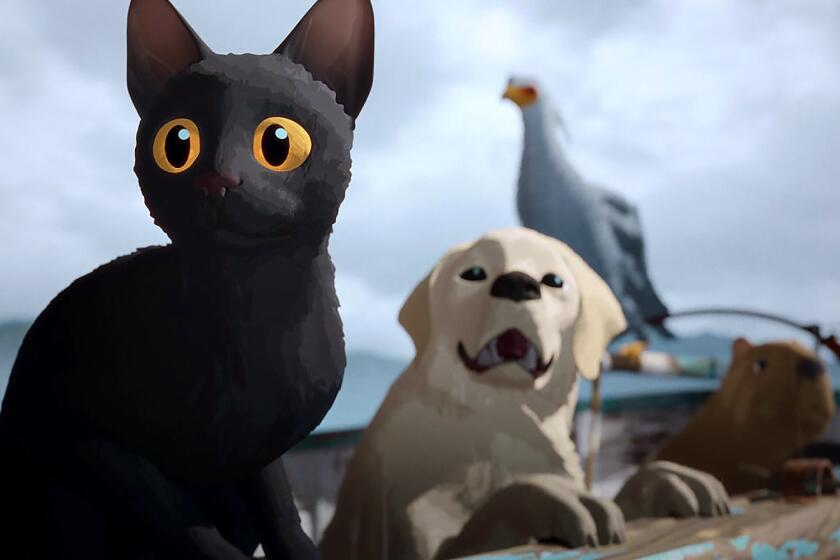The Deeper South
In Hollywood’s myopic eyes, the American South is usually depicted in one of two ways. It’s either a gothic swamp of racist brutality and towheaded ignorance or a placidly picturesque “Mayberry RFD” full of feisty-genteel females and Red Man-chawin’ good ol’ boys.
Yee-haw. It’s a strangely reductive vision of America’s most heavily mythologized region, a complex, loamy, deeply conflicted place.
For the record:
12:00 a.m. March 23, 2001 For the Record
Los Angeles Times Friday March 23, 2001 Home Edition Calendar Part F Page 2 Entertainment Desk 2 inches; 41 words Type of Material: Correction
Southern references--In a Feb. 20 Calendar story about Hollywood’s depictions of the South, the home state of Lynyrd Skynyrd was mistakenly reported. The band is from Florida. The story also erroneously referred to the state involved in a recent debate over its flag. The state is Georgia.
But despite the bicoastal establishment’s often dismissive views, the South retains a powerful hold on the national dream life. Like the city-states of New York, Los Angeles and Washington, D.C., the South simultaneously intrigues and repels outsiders; it seems to be in America but not entirely of it. At a time when so much of our culture has been flattened into brand-name homogeneity, the South clings to a certain backward-looking detachment, a tenacious Otherness, in imagination if not necessarily in reality.
That much is evident from two recently opened feature films: Sam Raimi’s honeysuckle-noir thriller “The Gift,” set in contemporary small-town Georgia, and “O Brother, Where Art Thou?,” Joel and Ethan Coen’s whimsical re-imagining of Homer’s “The Odyssey,” a whacked-out version of Depression-era rural Mississippi.
Radically different in style, tone and subject matter, both films, to varying degrees, offer new spins on the Old and New South. But though “The Gift” tends to recycle moonlight-and-magnolia cliches, “O Brother”--in the Coens’ sly, hyper-literate manner--tugs apart some defining myths of Southern culture and reweaves them into the broader tapestry of 20th century Americana.
It’s small wonder that Hollywood is rediscovering the South. Culturally speaking, the states below the Mason-Dixon line share a track record few parts of America can touch. Pick virtually any field--music, literature, spirituality, the culinary arts, architecture (think of Jefferson’s Monticello or New Orleans’ French Quarter)--and the impact of Southerners, black and white, is as pervasive as the scent of lemon verbena on a warm May night in Montgomery.
Yet you’d hardly guess it from the majority of Hollywood’s Dixie-fried fare. Whether well-meaning liberal parables (“Driving Miss Daisy”), bittersweet distaff comedies (“Steel Magnolias”) or moralistic fever dreams (“Deliverance”), the South of postwar Hollywood movies is usually portrayed as an exotic backwater in which hypocrisy, racist hysteria and sexual repression seethe just below the polite surface.
Recent History Perpetuates the Image
The region frequently hasn’t fared much better in popular music. For every Hoagy Carmichael gently crooning “Georgia on My Mind” there’s Billie Holiday beautifully lamenting Jim Crow’s bitter legacy of “Strange Fruit” (a song about lynching) and Neil Young caustically evoking the sound of “bullwhips cracking” in “Southern Man” (which drew an equally caustic response from Alabama rockers Lynyrd Skynyrd).
Recent events like the Florida vote-counting debacle, the heated debate over South Carolina’s Confederate-inspired state flag (which was modified a few weeks ago) and a controversial interview given by U.S. Atty. Gen. John Ashcroft to a magazine sympathetic to the Confederacy perpetuate the image of the South as the Land That Time Forgot, a place where, no matter how many new NFL franchises and Disney World attractions you add, nothing fundamental really changes.
That’s partly the landscape we encounter in “The Gift,” which stars Cate Blanchett as Annie Wilson, a widowed mother of three who uses her natural empathy and fortune-telling skills to keep food on the table. Many familiar signposts of the Southern mise en scene dot the movie’s background: Confederate license plates, a steamy bayou, trees draped in Spanish moss. We see Piggly Wiggly shopping bags and the inevitable Bell South phone booths, along with the inevitable pouty Southern belle.
The plot is built around classic Southern gothic motifs: adultery, murder, incest, corruption in high places. But perhaps most noteworthy about “The Gift” is the way it frames the South’s two most historically determining features: race relations and religion.
Beginning in the late 1950s, and coinciding with the start of the civil rights movement, it became nearly impossible to set a movie in the South without addressing race, however superficially. In the ‘60s and ‘70s, films like “To Kill a Mockingbird,” “In the Heat of the Night,” “Sounder” and the TV miniseries “Roots” opened the pop-culture door to Southern racial attitudes. The late ‘80s and early ‘90s took an even dimmer view of the region’s racial politics in such films as “Mississippi Burning,” “The Long Walk Home” and “Ghosts of Mississippi.”
But as the Arkansas-born and bred “Bubba” Clinton entered the White House, a more benign and wistful view of the South gained favor in movies like “Rambling Rose,” “Fried Green Tomatoes,” “Daughters of the Dust,” “Ruby in Paradise” and “Forrest Gump.”
Forget the Original Sin of racism: In the ‘90s the “New South”--with arriviste Atlanta as its capital--was far more likely to be lambasted for its Olympian civic pretensions, sterile shopping malls and L.A.-like commuter sprawl, as in Tom Wolfe’s novel “A Man In Full.”
In “The Gift,” race barely registers at all, and not simply because the movie contains not a single major or secondary black character. Blacks and whites are seen mixing freely at a country club, and the only white to utter a racist epithet is the unsavory wife-beater played (very convincingly) by Keanu Reeves.
There is also little in the movie to indicate we’re in the buckle of the Bible Belt, apart from some stray references to thinking “un-Christian thoughts” and the background drone of a televangelist during one spooky scene. Director Raimi and screenwriters Billy Bob Thornton and Tom Epperson, however, use these details mainly for atmosphere, with no bearing on plot or character development.
The Southern accents are pretty spotty too, but then, they also were in “Gone With the Wind,” with three of its four main characters played by British actors.
Whereas “The Gift” treats its familiar Southern tropes more or less as window dressing, “O Brother” manipulates them, consciously and amusingly.
Like the Hollywood depicted in the Coens’ “Barton Fink” and the Great Plains of their “Fargo,” the South of “O Brother” is filtered twice: first through the brothers’ satirical sensibility, then through the prism of 1930s Hollywood movies and traditional Southern bluegrass music. Recasting an old Hollywood genre--the prison movie--in their own tongue-in-cheek mythopoetic terms, the Coens depict a South on the verge of sweeping changes that will lead to the unraveling of its centuries-old social fabric.
Along with the coming of hydroelectric power, the biggest of these implied changes is the spread of American popular culture and its conversion into mass consumer culture: the Hollywood movies that gave many Southerners their first glimpse of glamorous Northern urban life, and the home-grown Southern music--bluegrass, gospel, blues and later rock ‘n’ roll--that would become the South’s most significant cultural export of the last half-century (not counting Krispy Kreme doughnuts).
Bluegrass Soundtrack Features Tradition
Already, much praise has been heaped on the movie’s superb bluegrass soundtrack, featuring both old and new (but traditional-sounding) songs by artists who include Emmylou Harris, Ralph Stanley, Alison Krauss and Gillian Welch. The disc has caught on with “crossover” record buyers and has been getting airplay on hip public radio stations.
Inadvertently, this raises a thorny issue: How will Southerners react to the Ivy League-educated Coens’ suggestion that their homeland can be fully liberated from itself only through outside intervention, just as it took the Tennessee Valley Authority to bring light to Appalachia and radio to create a nationwide bluegrass audience? Reportedly, the movie already has raised hackles below the Mason-Dixon line.
Yet the Coens’ film may signal a watershed of sorts. In John Boorman’s “Deliverance” (1972)--a brilliant, haunting movie that nonetheless bolstered an image of white Southerners as murderous, inbred goons--the building of a dam is symbolically and literally going to cover up the ugly deeds and primeval phobias of its male protagonists. In “O Brother” the raging waters that burst forth at film’s end are equated with baptism and resurrection, with second chances not only for the three spiritually redeemed convicts but also for the whole of Southern society. Sharp-eyed viewers may notice that one of the objects swept away in the deluge is a Confederate daguerreotype.
“Yes sir, the South is going to change,” muses the dashing convict-lawyer played by George Clooney. “It’s out with the spiritual mumbo jumbo and the backward ways.”
It may be a long while before the South of chain gangs, lynch mobs and the Scopes monkey trial is superseded in the popular imagination by the South of song and sweet smells, where individuals of different colors sometimes get along far better than do their self-righteous Northern counterparts.
However much perceptions change, the South probably will endure as a compelling region of the mind, a place where the present is in flux and the past, as William Faulkner famously put it, “is not dead. It isn’t even past.”
More to Read
Only good movies
Get the Indie Focus newsletter, Mark Olsen's weekly guide to the world of cinema.
You may occasionally receive promotional content from the Los Angeles Times.











